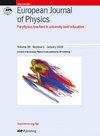An inexpensive way to introduce students to gamma spectroscopy
IF 0.8
4区 教育学
Q4 EDUCATION, SCIENTIFIC DISCIPLINES
引用次数: 0
Abstract
This paper presents two ways to introduce the student to some basic experimental concepts of gamma spectroscopy, without the use of expensive professional measurement equipment. For one, the complete experiment was simulated through several computer programs. Using this simulation, students are tasked with performing all the operations that must be performed in a real experimental setup, to obtain the spectrum of gamma radiation, as the expected result. For the second approach, equipment has been designed that looks and functions like real experimental equipment, and students can use it to perform completely identical procedures in the measurement process as with the real one. The central part of each component of a system designed in this way is a programmable microcontroller, set to perform a function analogous to that of the actual components. By working in these two ways, with a virtual experiment or a setup designed to fully imitate real measurement equipment, students can be introduced to the field of gamma spectroscopy and acquire a routine that can be repeated in real experiments. The main advantage of these two described methods is that they only require small investments.向学生介绍伽马能谱的廉价方法
本文介绍了两种方法,在不使用昂贵的专业测量设备的情况下,向学生介绍伽马能谱学的一些基本实验概念。其一,通过几个计算机程序模拟完整的实验。通过模拟实验,学生可以完成在真实实验装置中必须完成的所有操作,从而获得伽马射线的光谱,这是预期的结果。第二种方法是设计外观和功能都与真实实验设备相似的设备,学生可以使用这些设备在测量过程中执行与真实设备完全相同的程序。以这种方式设计的系统的每个组件的核心部分都是一个可编程微控制器,其功能与实际组件的功能类似。通过这两种方法,一种是虚拟实验,另一种是完全模仿真实测量设备设计的装置,可以把学生引入伽马能谱学领域,并掌握在真实实验中重复使用的常规方法。这两种方法的主要优点是只需少量投资。
本文章由计算机程序翻译,如有差异,请以英文原文为准。
求助全文
约1分钟内获得全文
求助全文
来源期刊

European Journal of Physics
物理-物理:综合
CiteScore
1.70
自引率
28.60%
发文量
128
审稿时长
3-8 weeks
期刊介绍:
European Journal of Physics is a journal of the European Physical Society and its primary mission is to assist in maintaining and improving the standard of taught physics in universities and other institutes of higher education.
Authors submitting articles must indicate the usefulness of their material to physics education and make clear the level of readership (undergraduate or graduate) for which the article is intended. Submissions that omit this information or which, in the publisher''s opinion, do not contribute to the above mission will not be considered for publication.
To this end, we welcome articles that provide original insights and aim to enhance learning in one or more areas of physics. They should normally include at least one of the following:
Explanations of how contemporary research can inform the understanding of physics at university level: for example, a survey of a research field at a level accessible to students, explaining how it illustrates some general principles.
Original insights into the derivation of results. These should be of some general interest, consisting of more than corrections to textbooks.
Descriptions of novel laboratory exercises illustrating new techniques of general interest. Those based on relatively inexpensive equipment are especially welcome.
Articles of a scholarly or reflective nature that are aimed to be of interest to, and at a level appropriate for, physics students or recent graduates.
Descriptions of successful and original student projects, experimental, theoretical or computational.
Discussions of the history, philosophy and epistemology of physics, at a level accessible to physics students and teachers.
Reports of new developments in physics curricula and the techniques for teaching physics.
Physics Education Research reports: articles that provide original experimental and/or theoretical research contributions that directly relate to the teaching and learning of university-level physics.
 求助内容:
求助内容: 应助结果提醒方式:
应助结果提醒方式:


